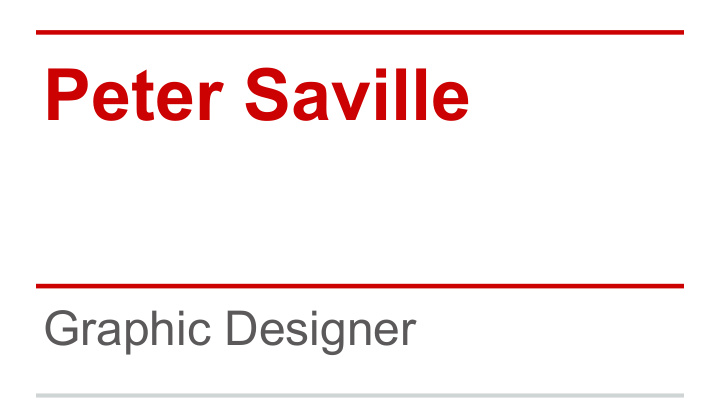



Peter Saville Graphic Designer
Background ● Born in Manchester in 1955 ● Studied Graphics at Manchester Polytechnic ● Enjoyed the music of Kraftwek, Roxy Music ● Malcolm Garrett encouraged him to discover the work of early modern movement typographers ○ Such as Herbet Bayer and Jan Tschichold
Influences
First Commercial Project - ‘The Factory’ ● Tschichold was the inspiration for Saville’s first commercial project. ○ The 1978 launch poster for ‘The Factory’ nightclub ● Based the poster on a found object of his own ○ An industrial warning sign
‘The Factory’ - Record Label ● In 1979, Tony Wilson launched a record label - Factory Records ● Saville became its art director and had almost complete freedom ● He treated his artwork for the Factory acts as a form of self expression
Development in Style ● Late 1970s - ○ Early Modernist Symbolism ● Early 1980s - ○ Juxtaposition of classical art historical references with complex coding systems
Power Corruption And Lies, New Order, 1983
Change of Direction ● Saville was sought after by mainstream acts ○ But he wanted to strip away excess from his work ● He took inspiration from the ‘last great period of modernism’ ○ the late 1950s and 1960s ● Produced a silkscreen style images for New Order’s album Technique
Timeline of change
Typography Typography is a very effective signifier of time ➔ “For me the period of typography as a highly valuable ➔ energy has gone” The effectiveness of type has blossomed over the last 25 ➔ years and Helvetica was a strong feature in the progressive and influential iconography of our times. First started playing with Helvetica in 1987 ➔ Used it for a deliberate recognition of the 60’s in the ◆ 80s “Helvetica is completely overused” ➔ ➔ “Helvetica takes on characteristics of the name you are writing”.
Commercial Peak Saville reached a creative and commercial peak
Fashion
Lacoste
England football shirt Attempts to use graphic design to make a statement about the nature of modern England
Discussion Questions Do you think it is a good move to change your style in order to fit in with contemporary design? Or is it better to stick to your roots and risk the chance of commercial rejection?
Bibliography http://www.marketingmanchester.com/original-modern/peter-saville.aspx http://www.bbc.co.uk/manchester/arts/2004/01/22/saville_iv1.shtml http://www.dezeen.com/2013/09/20/design-by-peter-saville/ http://www.eyemagazine.com/feature/article/reputations-peter-saville http://lovedesignetc.wordpress.com/2011/09/07/peter-saville-on-helvetica-and-typography/ www.petersaville.info/ http://www.theguardian.com/artanddesign/gallery/2013/sep/09/creative-genius-peter-saville-in-pictures http://www.theguardian.com/artanddesign/2013/sep/08/peter-saville-uks-famous-graphic-designer http://www.petersaville.com/ http://designmuseum.org/design/peter-saville http://www.hardformat.org/designers/peter-saville-designer/
Recommend
More recommend